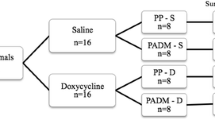Abstract
With regard to the pathogenesis of recurrent incisional hernia, an impaired connective tissue quality leading to an aberrant scarring process has been proposed. For the matrix metalloproteinase (MMP-2) a pathogenetic involvement in direct inguinal hernia development is reported. With mesh implantation as the gold standard treatment for incisional hernias, the aim of the present study was to investigate the MMP-2 expression in patients with recurrent incisional hernias with and without mesh-materials. In primary fibroblast cultures obtained from skin scars in patients with and without recurrent incisional hernias, MMP-2 synthesis and gene expression were investigated. Furthermore, MMP-2 synthesis and gene expression of fibroblasts were compared after incubation with two different mesh materials: polypropylene and absorbable polyglactin filaments. MMP-2 enzyme activity was determined by semiquantitative zymography and mRNA synthesis by quantitative RT-PCR. Both MMP-2 enzyme activity and mRNA expression were similar in hernia and control fibroblasts in vitro. In control fibroblasts mesh incubation did not significantly affect MMP-2 expression, whereas polypropylene mesh contact of fibroblasts from patients with recurrent incisional hernias led to a major decrease of MMP-2 activity and of mRNA expression. In the absence of biomaterials fibroblasts from recurrent incisional hernia, patients have no alterations of their MMP-2 synthesis compared to control fibroblasts, whereas a specific response was found after biomaterial contact hereby indicating differences in fibroblast phenotype.





Similar content being viewed by others
References
Uden A, Lindhagen T (1988) Inguinal hernia in patients with congenital dislocation of the hip. A sign of general connective tissue disorder Acta Orthop Scand 59:667–668
Liem MS, van der GY, Beemer FA, van Vroonhoven TJ (1997) Increased risk for inguinal hernia in patients with Ehlers-Danlos syndrome Surgery 122:114–115
Girotto JA, Malaisrie SC, Bulkely G, Manson PN (2000) Recurrent ventral herniation in Ehlers-Danlos syndrome Plast Reconstr Surg 106:1520–1526
Hall KA, Peters B, Smyth SH, Warneke JA, Rappaport WD, Putnam CW, Hunter GC (1995) Abdominal wall hernias in patients with abdominal aortic aneurysmal versus aortoiliac occlusive disease Am J Surg 170:572–575
Pleumeekers HJ, De Gruijl A, Hofman A, Van Beek AJ, Hoes AW (1999) Prevalence of aortic aneurysm in men with a history of inguinal hernia repair Br J Surg 86:1155–1158
Flum DR, Horvath K, Koepsell T (2003) Have outcomes of incisional hernia repair improved with time? A population-based analysis Ann Surg 237:129–135
Si Z, Rhanjit B, Rosch R, Rene PM, Klosterhalfen B, Klinge U (2002) Impaired balance of type I and type III procollagen mRNA in cultured fibroblasts of patients with incisional hernia Surgery 131:324–331
Klinge U, Si ZY, Zheng H, Schumpelick V, Bhardwaj RS, Klosterhalfen B (2001) Collagen I/III and matrix metalloproteinases (MMP) 1 and 13 in the fascia of patients with incisional hernias J Invest Surg 14:47–54
Klinge U, Si ZY, Zheng H, Schumpelick V, Bhardwaj RS, Klosterhalfen B (2000) Abnormal collagen I to III distribution in the skin of patients with incisional hernia Eur Surg Res 32:43–48
Bellon JM, Bajo A, Ga-Honduvilla N, Gimeno MJ, Pascual G, Guerrero A, Bujan J (2001) Fibroblasts from the transversalis fascia of young patients with direct inguinal hernias show constitutive MMP-2 overexpression Ann Surg 233:287–291
Jackson SR, Avery NC, Tarlton JF, Eckford SD, Abrams P, Bailey AJ (1996) Changes in metabolism of collagen in genitourinary prolapse Lancet 347:1658–1661
Sakalihasan N, Delvenne P, Nusgens BV, Limet R, Lapiere CM (1996) Activated forms of MMP2 and MMP9 in abdominal aortic aneurysms J Vasc Surg 24:127–133
Longo GM, Xiong W, Greiner TC, Zhao Y, Fiotti N, Baxter BT (2002) Matrix metalloproteinases 2 and 9 work in concert to produce aortic aneurysms J Clin Invest 110:625–632
Zheng H, Si Z, Kasperk R, Bhardwaj RS, Schumpelick V, Klinge U, Klosterhalfen B (2002) Recurrent inguinal hernia: disease of the collagen matrix? World J Surg 26:401–408
Turck J, Pollock AS, Lee LK, Marti HP, Lovett DH (1996) Matrix metalloproteinase 2 (gelatinase A) regulates glomerular mesangial cell proliferation and differentiation J Biol Chem 271:15074–15083
van der Linden FT, van Vroonhoven TJ (1988) Long-term results after surgical correction of incisional hernia Neth J Surg 40:127–129
Klosterhalfen B, Klinge U, Hermanns B, Schumpelick V (2000) [Pathology of traditional surgical nets for hernia repair after long- term implantation in humans] Chirurg 71:43–51
Klinge U, Klosterhalfen B, Conze J, Limberg W, Obolenski B, Ottinger AP, Schumpelick V (1998) Modified mesh for hernia repair that is adapted to the physiology of the abdominal wall Eur J Surg 164:951–960
Kama NA, Coskun T, Yavuz H, Doganay M, Reis E, Akat AZ (1999) Autologous skin graft, human dura mater and polypropylene mesh for the repair of ventral abdominal hernias: an experimental study Eur J Surg 165:1080–1085
Bellon JM, Bujan J, Contreras LA, Carrera-San Martin A, Jurado F (1996) Comparison of a new type of polytetrafluoroethylene patch (Mycro Mesh) and polypropylene prosthesis (Marlex) for repair of abdominal wall defects J Am Coll Surg 183:11–18
Klinge U, Klosterhalfen B, Birkenhauer V, Junge K, Conze J, Schumpelick V (2002) Impact of polymer pore size on the interface scar formation in a rat model J Surg Res 103:208–214
Junge K, Klinge U, Klosterhalfen B, Mertens PR, Rosch R, Schachtrupp A, Ulmer F, Schumpelick V (2002) Influence of mesh materials on collagen deposition in a rat model. J Invest Surg 15:319–328
Olaso E, Labrador JP, Wang L, Ikeda K, Eng FJ, Klein R, Lovett DH, Lin HC, Friedman SL (2002) Discoidin domain receptor 2 regulates fibroblast proliferation and migration through the extracellular matrix in association with transcriptional activation of matrix metalloproteinase-2 J Biol Chem 277:3606–3613
Acknowledgements
This work was supported by IZKF-BIOMAT, RWTH-Aachen, project no. TV B66 and by the Deutsche Forschungsgemeinschaft grant KL 1320/2–1. Mesh materials were kindly provided by Ethicon, Hamburg, Germany.
Author information
Authors and Affiliations
Corresponding author
Additional information
This work was supported by IZKF-BIOMAT, RWTH-Aachen, project no. TV B66 and by the Deutsche Forschungsgemeinschaft grant KL 1320/2-1
Rights and permissions
About this article
Cite this article
Rosch, R., Lynen-Jansen, P., Junge, K. et al. Biomaterial-dependent MMP-2 expression in fibroblasts from patients with recurrent incisional hernias. Hernia 10, 125–130 (2006). https://doi.org/10.1007/s10029-005-0060-4
Received:
Accepted:
Published:
Issue Date:
DOI: https://doi.org/10.1007/s10029-005-0060-4




